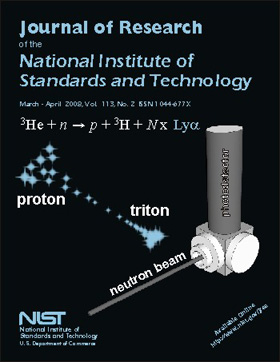About the Electron and Optical Physics Division
The Division, part of
NIST's Physics
Laboratory,
develops measurement capabilities needed by emerging electronic and optical
technologies, particularly those required for submicrometer fabrication and
analysis. In pursuit of this mission, it maintains an array of research,
measurement, and calibration activities.
|
 |
 |
Research Areas
The Electron and
Optical Physics Division is divided into two groups: |
| |
|
 |
Photon Physics
Group: performs research in the areas of far ultraviolet and extreme
ultraviolet (EUV) physics. |
| |
|
 |
Far Ultraviolet Physics Group: is
responsible for SURF III operations and for source-based radiometry
and calibration services in the far UV and soft x-ray spectral
regions. |
|
 |
 |
For the first time, Lyman alpha light at a wavelength of 121.6 nm has been observed as a product of the
3He(n,tp) nuclear reaction occurring in a cell of 3He gas.
An experiment carried out at the NIST Center for Neutron Research
between the Electron and Optical Physics Division,
the Neutron Interactions and Dosimetry Group
and the University of Maryland found that tens of Lyman alpha photons are
produced in a cell at atmospheric pressure. A report on this experiment has been published in the
March-April 2008 issue of the
Journal of Research of the National Institute of Standards
and Technology, and provides the cover illustration for that issue, shown above.
The Lyman alpha mode of detecting neutrons offers significant advantages over the 3He
proportional-counter technology upon which NIST's primary neutron dosimetry is currently based.
Proportional counters utilize an electrical discharge initiated by the same 3He(n,tp) reaction.
The quench times of Lyman alpha emission are expected to be much shorter than those of electrical discharges,
offering a detection mechanism with intrinsically higher dynamic range, without use of high voltages in the reaction cell.
Initial experimental results on the Lyman alpha neutron detector indicate that single-neutron sensitivity may be possible.
Prospective applications of Lyman alpha neutron detector technology range from improved accuracy in measurements of the
neutron lifetime and magnetic and electric dipole moments, to radiation detectors with higher dynamic range,
sensitivity and background rejection, for use in portal monitors and personal protective equipment for first responders.
NIST has applied for a patent on this technology.
For further information, see "Observation
of the 3He(n,tp)Reaction by Detection of Far-Ultraviolet Radiation,"
Alan K. Thompson, Michael A. Coplan, John W. Cooper, Patrick P. Hughes, Robert E. Vest and Charles Clark,
J. Res. Nat. Inst. Standards Tech. 113, 69 (2008)
Technical inquiries:
Charles Clark
National Institute of Standards and Technology
100 Bureau Drive, Stop 8410
Gaithersburg, MD 20899-8410
Website comments: Feedback |
NIST Conferences
NIST Visitor Info
General NIST inquiries:
Public Inquiries Unit:
(301) 975-NIST (6478)
TTY (301) 975-8295
|
|
 |


